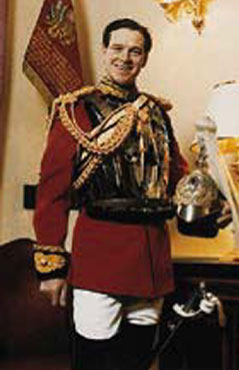Co-editors: Seán Mac Mathúna • John Heathcote
Consulting editor: Themistocles Hoetis
Field Correspondent: Allen Hougland
|
Diana crash inquiry report: Final report by Paris prosecutor's office MI6 and the Princess of Wales by Richard Tomlinson MI6's plot to assassinate President Milosevic of Serbia in 1992 by Richard Tomlinson |
 Major James Hewitt: Diana told him of the threats to her life and how Barry Mannakee had been "murdered" The first suspicious death connected with Diana was when her bodyguard Barry Mannakee (who is rumoured to have become her lover in 1985) died in unexplained motorbike crash in 1987. Afterwards, according to the former Conservative MP Charles Wardle, Diana feared for her life. In a speech in the House of Commons (Hansard, 22nd June 1999), Wardle stated: "Diana's remarks to Al Fayed concerned the royal household's antipathy to her; its habitually close links with the security services; the manipulation, interference, and control, as she saw it, exercised by official's of the household; her conviction, based on what she said she had been told, that Barry Mannakee's death was not an accident; and her apprehension that she, too, would be assassinated" Wardle also mentioned Major James Hewitt, one of Diana's lovers, who allegedly received threats from the royal family if he did not stop his relationship with Diana: "Hewitt said that he had received threats to his life. Patrick Jephson, a private secretary, said his safety could not be guaranteed. Members of the (royal) household told him that his safety would be in peril if he did not back off. Anonymous telephone calls warned him that he would meet that same fate as Barry Mannakee. He said that the Princess of Wales took the threats seriously and told him that Mannakee had been murdered" (Hansard, 22nd June 1999). According to the Sunday Mirror (4th January 1998), Princess Diana told Stephen Twigg, one of her therapists, that she "feared for her life" because she become the royal families "loose cannon". Similar threats were allegedly made in 1993 to Linda St. Clair, the leader of the Corrective Party, who claims she fled Britain "after establishment death threats". She says that she was approached by two men (who she believes were working for Special Branch or MI5) who threatened kill her and her family unless she disappeared. She promised to say nothing about a list of senior MP's and "other public figures" which she alleges have used her services as a prostitute, and left the country. Apparently, one the men said to St. Clair: "You have been upsetting a lot of MP's. They have sent us to sort you out. Keep your mouth shut about them or you're dead. Don't mess with the big boys" (The Guardian, 14th April 1993). In April 2000, Wardle - who has since become a paid company director for Al Fayed - made the following comments in The Guardian (4th April 2000): In August 1997 the terrible car crash in Paris pitched Mohamed Al Fayed into a bitter conflict with the British establishment that will not be resolved until there Is a comprehensive account of many still unexplained aspects of the tragedy. One does not have to subscribe to conspiracy theories about the death of the mother of the future king of England to appreciate that the Paris inquiry left many vital questions unanswered. I shall mention just a few. |
|
|
|